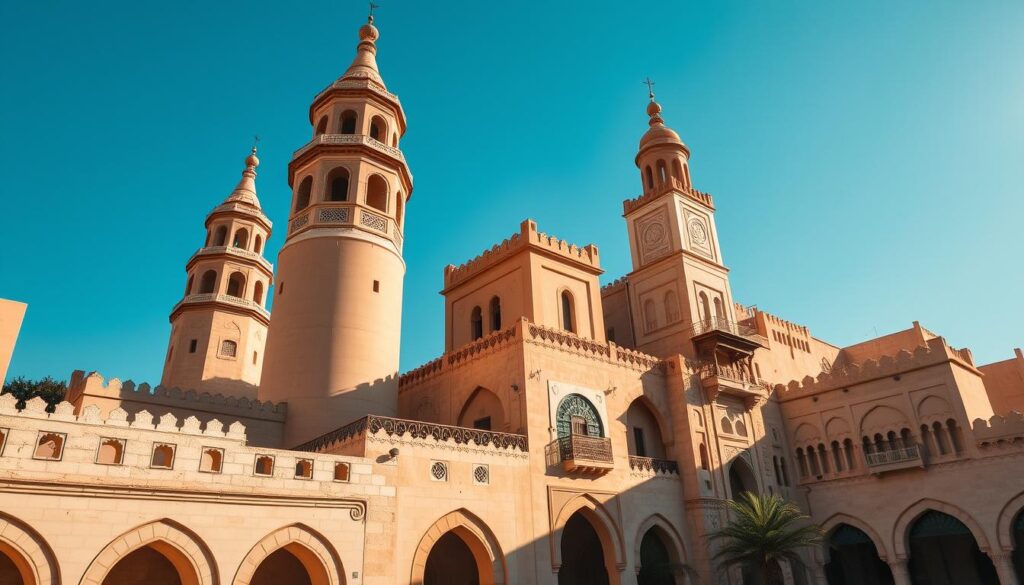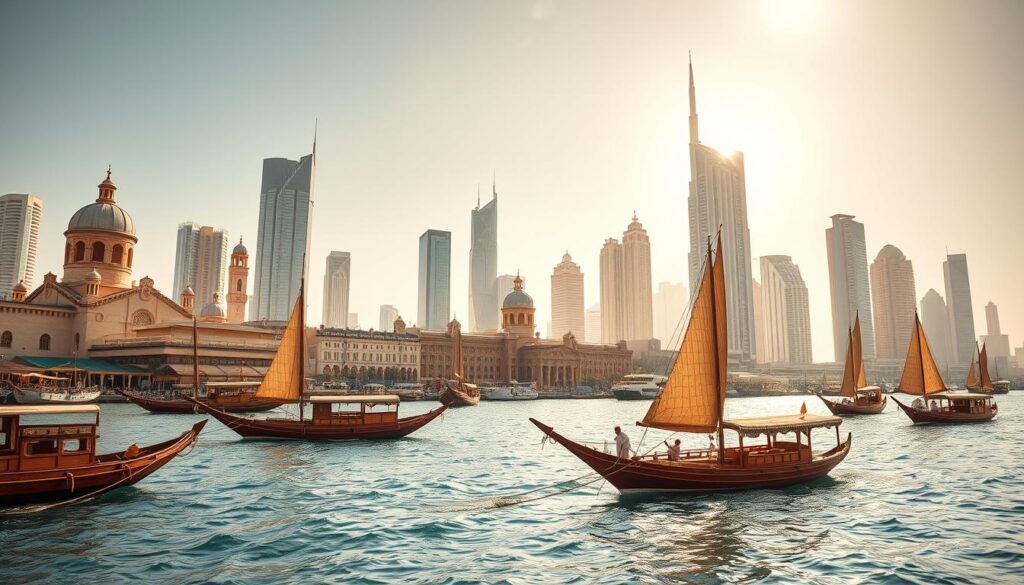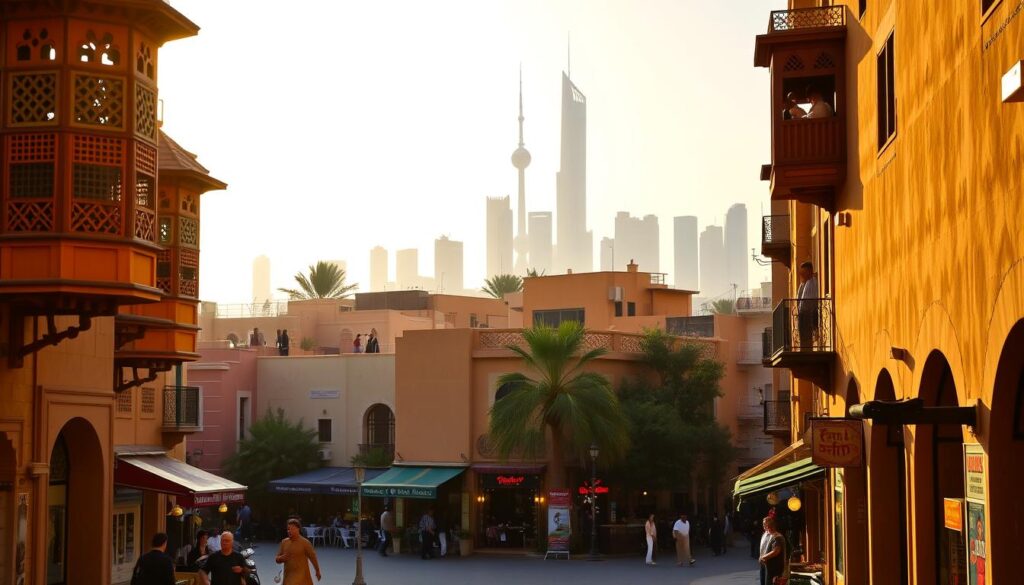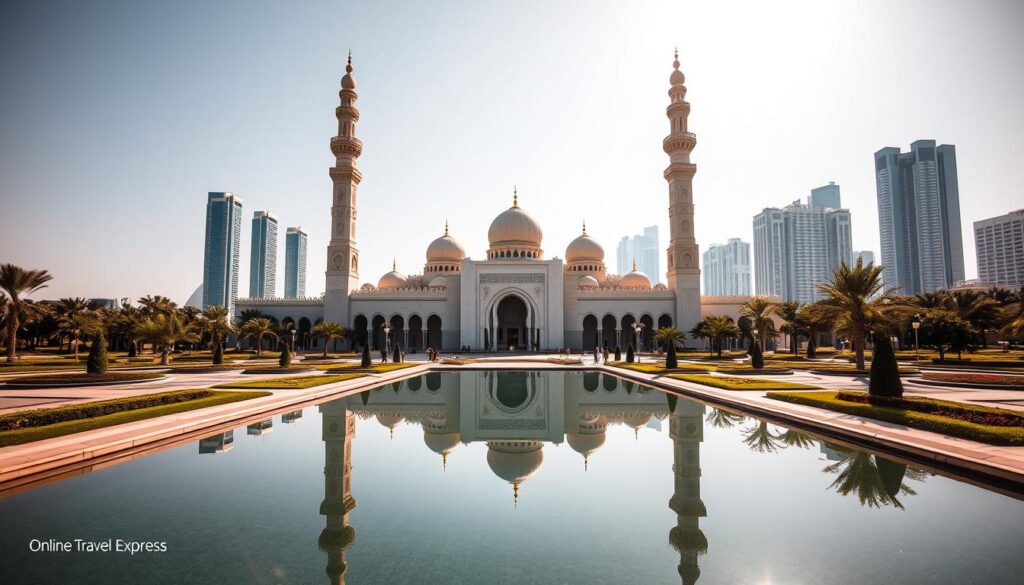Did you know Dubai’s history goes back over 4,000 years? It’s much older than its famous skyscrapers. The city’s rich culture offers more than just modern buildings. Exploring Dubai’s historical and cultural sites shows a story of change and strength.
Dubai’s landmarks tell a story of a small fishing village becoming a world city. You’ll find ancient forts and traditional areas that most tourists miss. The historical landmarks in Dubai show the emirate’s amazing cultural mix.
Visiting Dubai’s cultural spots reveals hidden treasures. You’ll see the area’s traditions and new ideas. Each place gives a special look into Dubai’s history, from pearl diving to modern buildings that mix old and new.
Key Takeaways
- Dubai’s history extends far beyond its modern skyline
- Cultural sites offer profound insights into local heritage
- Historical landmarks showcase Dubai’s incredible transformation
- Traditional architecture reveals unique cultural stories
- Exploring historical sites provides deeper travel experiences
Discover the Rich History of Al Fahidi District
Dubai’s Al Fahidi Historical Neighborhood is a window into the emirate’s past. This remarkable cultural attraction in the UAE takes visitors back in time. It shows the true spirit of Dubai’s traditional sites.

The district shows Dubai’s architectural roots. Its unique design and history are key. Narrow streets and traditional buildings tell stories of resilience and preservation.
Strolling Through the Al Fahidi Historic District
Exploring the district, you’ll see amazing features of traditional Emirati architecture:
- Wind towers (barajeel) for natural cooling
- Coral stone and wooden structures
- Intricate wooden doors and decorations
- Narrow alleyways for desert heat protection
Visiting the Dubai Museum at Al Fahidi Fort
The Dubai Museum is inside the historic Al Fahidi Fort. It takes you on a journey through Dubai’s history. You’ll see artifacts, exhibits, and multimedia that make history come alive.
| Museum Highlights | Cultural Significance |
|---|---|
| Archaeological discoveries | Prehistoric UAE settlements |
| Traditional lifestyle exhibits | Bedouin culture and maritime heritage |
| Historical photographs | Dubai’s urban development |
Exploring Traditional Emirati Architecture
The architecture in Al Fahidi shows smart design for the desert. Thick walls, small windows, and wind towers help create comfortable homes.
Al Fahidi is not just a neighborhood; it’s a living museum of Dubai’s cultural evolution.
Dive into the Cultural Hub of Dubai Creek
Dubai Creek is a stunning historical landmark that has shaped the city’s journey. It has been the heart of Dubai’s trading heritage, linking Deira and Bur Dubai for ages. As a key Dubai heritage site, it gives visitors a deep look into the city’s rich culture.

Exploring the creek tells the story of Dubai’s growth. It has been a vital trade route for centuries, boosting the city’s economy. You’ll see why historical places in Dubai like Dubai Creek are essential to understanding the emirate’s history.
The Significance of Dubai Creek in History
The creek was crucial to Dubai’s economy. Traders from India, Iran, and other countries used it to trade goods, creating a lively multicultural scene. Key historical points include:
- Maritime trade hub since the early 20th century
- Connection point for pearl diving and fishing communities
- Catalyst for Dubai’s economic transformation
Cruise the Creek for a Unique Perspective
A traditional abra (water taxi) ride gives a unique view of Dubai’s history. These wooden boats let you experience the waters that traders once used.
Sightseeing at the Gold and Spice Souks
Next to the creek, the Gold and Spice Souks show Dubai’s trading past. These markets are full of colors, smells, and detailed crafts.
| Souk Type | Notable Features | Cultural Significance |
|---|---|---|
| Gold Souk | Over 300 jewelry shops | Reflects trading traditions |
| Spice Souk | Hundreds of spice vendors | Represents culinary heritage |
Your trip through Dubai Creek connects you with the emirate’s captivating history. It offers a memorable look into its cultural roots.
Experience the Charm of Bastakiya Quarter
In the heart of Dubai, the Bastakiya Quarter is a hidden gem. It takes you back in time. This historic area shows the real culture of the UAE.

Exploring Bastakiya, you’ll see amazing Arabian architecture. It tells the story of the UAE’s rich culture.
Unique Features of Bastakiya Architecture
The quarter has special architectural features. They show the creativity of old UAE design:
- Intricate wind towers (malqaf) for natural cooling
- Narrow alleyways with limestone and coral block buildings
- Ornate gypsum decorations and wooden mashrabiya screens
Local Art Galleries and Cultural Spaces
Bastakiya is now a cultural center. It has many art galleries and creative spots. Art lovers can check out:
- XVA Gallery – featuring contemporary Middle Eastern art
- Majlis Gallery – showcasing traditional and modern artwork
- Various boutique museums highlighting local creativity
Enjoying Traditional Coffee at the Arabian Tea House
Don’t miss the Arabian Tea House in Bastakiya. Enjoy Emirati coffee and traditional drinks. It’s a peaceful spot to relax.
| Experience | Highlights |
|---|---|
| Architecture | Preserved 19th-century buildings |
| Art Galleries | Multiple contemporary and traditional spaces |
| Dining | Authentic Arabian Tea House |
Pro tip: Visit during the cooler morning hours to fully appreciate the architectural details and cultural richness of Bastakiya Quarter.
Uncover the Splendor of Jumeirah Mosque

Dubai’s culture is more than its tall buildings. The Jumeirah Mosque is a key part of the city’s heritage. It’s one of the few mosques in the UAE that lets non-Muslims inside, showing Islamic culture and traditions.
The mosque is a standout historical and cultural site in Dubai. It’s designed like medieval mosques, with a white marble exterior and detailed designs. These features make it a beautiful example of Islamic architecture.
Architectural Highlights of Jumeirah Mosque
Visitors can see the mosque’s amazing architecture:
- Traditional Islamic architectural design
- Stunning white marble construction
- Intricate geometric patterns
- Elegant minarets and domes
Guided Tours: Learn About Emirati Culture
The Sheikh Mohammed Centre for Cultural Understanding gives tours. These tours teach about Emirati culture. You can:
- Explore the mosque’s interior
- Learn about Islamic practices
- Engage in cultural discussions
- Ask questions about local traditions
Importance of Religious Tolerance in Dubai
The Jumeirah Mosque shows Dubai’s dedication to religious tolerance. It welcomes people from all backgrounds. This makes it a key cultural spot in the UAE, helping to bring communities together.
“Understanding comes through open dialogue and shared experiences” – Dubai Cultural Philosophy
Visit the Iconic Sheikh Saeed Al Maktoum House
Explore one of Dubai’s key historical spots, the Sheikh Saeed Al Maktoum House. This site gives a deep look into Dubai’s cultural history. It’s in the Al Shindagha neighborhood, showing Dubai’s architectural and historical importance.
The house is a prime example of Dubai’s architectural styles. Built in the late 19th century, it has traditional Arabic designs. These designs show the region’s architectural heritage:
- Intricate wind tower ventilation systems
- Coral stone construction
- Detailed wooden mashrabiya screens
- Expansive courtyards
Historical Significance of the Residence
Sheikh Saeed Al Maktoum House was once home to Dubai’s ruling family. It offers a close look at Dubai’s growth. Today, it houses a museum that tells Dubai’s story from a small fishing village to a global city.
Exhibits Showcasing Dubai’s Past
Visitors can see collections that highlight Dubai’s history. The exhibits include:
- Historical photographs documenting urban development
- Rare coins and stamps
- Traditional family artifacts
- Archival documents revealing local governance
Architectural Styles of the Historic House
The house’s design reflects cultural connections. It combines Persian, Arabic, and local Emirati styles. This makes it a symbol of Dubai’s architectural heritage. Its preserved rooms and details give visitors a real feel of the past.
For history buffs or cultural explorers, the Sheikh Saeed Al Maktoum House is a must-see. It offers a unique journey through Dubai’s fascinating history.
Explore Heritage Village and Traditional Handicrafts
Dubai’s Heritage Village is a window into the UAE’s rich culture. It’s a living museum among Dubai’s traditional sites. Here, you can dive into Emirati history and see traditional crafts up close.
Walking into this historical place in Dubai, you enter a world of Emirati traditions. These traditions have been passed down for generations. The village lets you see the skills and cultural practices that shaped the region for centuries.
Experience Traditional Emirati Crafts
At the Heritage Village, you can see artisans working on crafts that show the UAE’s cultural heritage:
- Pottery making using traditional techniques
- Intricate textile weaving
- Metalwork and blacksmithing
- Traditional pearl diving equipment demonstrations
Engaging Cultural Activities and Workshops
The Heritage Village offers hands-on experiences that bring Emirati culture to life. You can join workshops on:
- Traditional Arabic calligraphy
- Handcrafted jewelry making
- Authentic cooking classes
- Traditional textile design
Understanding Bedouin Culture
Discover the world of Bedouin life through traditional dwellings and cultural exhibits. The village gives you a deep look into the nomadic lifestyle that shaped the region’s history.
| Craft | Cultural Significance | Demonstration Frequency |
|---|---|---|
| Pottery | Represents ancient artisan skills | Daily |
| Weaving | Showcases traditional textile techniques | Hourly |
| Metalwork | Highlights historical craftsmanship | Multiple times daily |
Pro tip: Visit in the morning for the best craft demonstrations. It’s less crowded and more authentic.
Connect with Nature at the Dubai Desert Conservation Reserve
The Dubai Desert Conservation Reserve is a hidden gem in Dubai. It’s a place where you can connect with nature away from the city’s bright lights. This reserve offers a unique experience that lets you see the beauty of the natural world.
Preserving Natural Heritage
The reserve is key in protecting the UAE’s desert. It helps keep native wildlife and plants safe. This shows how much the Emiratis care for their environment.
Desert Safari Exploration
Going on a desert safari is an adventure. You’ll see a world full of life in the desert. The reserve lets you experience:
- Native desert plants and resilient vegetation
- Rare wildlife adapted to extreme conditions
- Stunning desert landscapes and panoramic views
The Arabian Oryx: A Symbol of Resilience
The Arabian Oryx is a symbol of conservation success. It was once close to extinction but is now thriving thanks to conservation efforts.
| Species Characteristic | Details |
|---|---|
| Native Habitat | Arabian Peninsula Desert |
| Conservation Status | Vulnerable (Recovering) |
| Population in Reserve | Approximately 500-600 individuals |
Visiting the Dubai Desert Conservation Reserve teaches you about environmental care and cultural preservation. It’s a chance to see the region’s dedication to these values.
Discover the Legacy of the Dubai Aquarium
Dubai’s cultural attractions go beyond its famous skyscrapers. The Dubai Aquarium is a key example of the city’s bond with marine life. It offers a deep dive into the underwater world of the UAE, mixing education, conservation, and cultural tales.
This aquarium is a top spot in Dubai, showing the city’s rich maritime history. It’s more than just a tourist attraction. It’s a journey into the marine ecosystems of the Arabian Gulf.
Unique Educational Experiences
The Dubai Aquarium is full of learning opportunities. It brings marine science to life with interactive exhibits. You can see the rich marine life of the Arabian Gulf up close.
- Guided marine biology workshops
- Live feeding demonstrations
- Virtual reality marine exploration experiences
Marine Conservation Efforts
Dubai is dedicated to protecting the environment, and the aquarium shows this. It plays a big role in saving local marine ecosystems. This is done through research and protection programs.
| Conservation Program | Focus Area | Impact |
|---|---|---|
| Coral Reef Restoration | Gulf Marine Ecosystem | Protecting endangered coral species |
| Marine Wildlife Tracking | Arabian Sea Biodiversity | Monitoring endangered marine species |
Cultural Narratives of Marine Life
The aquarium connects UAE visitors with Emirati maritime stories. You’ll learn how the sea has influenced the region’s culture. From ancient pearl diving to today’s conservation efforts.
Appreciate Art and Culture at D3 (Dubai Design District)
Dubai Design District (D3) is a lively cultural spot that changes Dubai’s creative scene. It’s a top place for cultural attractions in the UAE, offering a deep dive into Dubai’s modern art. Here, new artists and designers meet to show off their latest creations.
D3 is a hidden gem in Dubai, offering a special place for creativity. It supports both local and international artists with modern galleries, design studios, and interactive areas. Year-round cultural events show its dedication to new art and cultural talks.
Exploring D3, you find a place where old Emirati art meets new design. Artists and designers work together in top-notch spaces, making new art that pushes limits. It shows Dubai’s dream of being a world creative center, welcoming visitors to see the UAE’s modern culture.
D3 is full of interactive shows and design classes, taking you deep into Dubai’s creative world. You’ll see how this place turns art dreams into real experiences. It’s a key spot for those wanting to get the UAE’s changing cultural scene.

